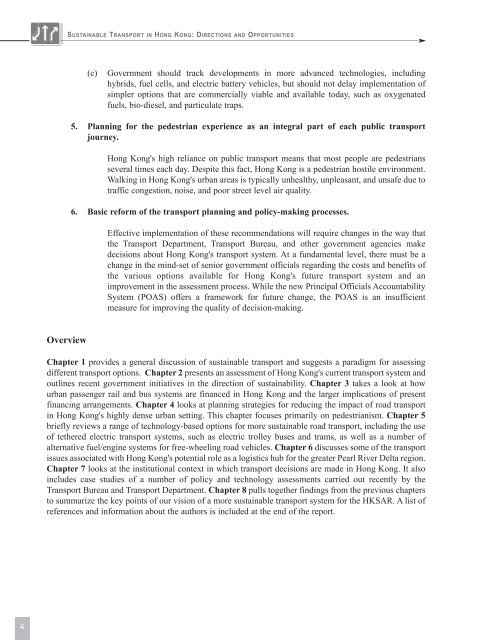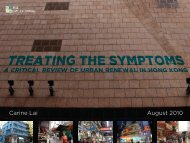Untitled - Civic Exchange
Untitled - Civic Exchange
Untitled - Civic Exchange
You also want an ePaper? Increase the reach of your titles
YUMPU automatically turns print PDFs into web optimized ePapers that Google loves.
SUSTAINABLE TRANSPORT IN HONG KONG: DIRECTIONS AND OPPORTUNITIES<br />
(c)<br />
Government should track developments in more advanced technologies, including<br />
hybrids, fuel cells, and electric battery vehicles, but should not delay implementation of<br />
simpler options that are commercially viable and available today, such as oxygenated<br />
fuels, bio-diesel, and particulate traps.<br />
5. Planning for the pedestrian experience as an integral part of each public transport<br />
journey.<br />
Hong Kong's high reliance on public transport means that most people are pedestrians<br />
several times each day. Despite this fact, Hong Kong is a pedestrian hostile environment.<br />
Walking in Hong Kong's urban areas is typically unhealthy, unpleasant, and unsafe due to<br />
traffic congestion, noise, and poor street level air quality.<br />
6. Basic reform of the transport planning and policy-making processes.<br />
Effective implementation of these recommendations will require changes in the way that<br />
the Transport Department, Transport Bureau, and other government agencies make<br />
decisions about Hong Kong's transport system. At a fundamental level, there must be a<br />
change in the mind-set of senior government officials regarding the costs and benefits of<br />
the various options available for Hong Kong's future transport system and an<br />
improvement in the assessment process. While the new Principal Officials Accountability<br />
System (POAS) offers a framework for future change, the POAS is an insufficient<br />
measure for improving the quality of decision-making.<br />
Overview<br />
Chapter 1 provides a general discussion of sustainable transport and suggests a paradigm for assessing<br />
different transport options. Chapter 2 presents an assessment of Hong Kong's current transport system and<br />
outlines recent government initiatives in the direction of sustainability. Chapter 3 takes a look at how<br />
urban passenger rail and bus systems are financed in Hong Kong and the larger implications of present<br />
financing arrangements. Chapter 4 looks at planning strategies for reducing the impact of road transport<br />
in Hong Kong's highly dense urban setting. This chapter focuses primarily on pedestrianism. Chapter 5<br />
briefly reviews a range of technology-based options for more sustainable road transport, including the use<br />
of tethered electric transport systems, such as electric trolley buses and trams, as well as a number of<br />
alternative fuel/engine systems for free-wheeling road vehicles. Chapter 6 discusses some of the transport<br />
issues associated with Hong Kong's potential role as a logistics hub for the greater Pearl River Delta region.<br />
Chapter 7 looks at the institutional context in which transport decisions are made in Hong Kong. It also<br />
includes case studies of a number of policy and technology assessments carried out recently by the<br />
Transport Bureau and Transport Department. Chapter 8 pulls together findings from the previous chapters<br />
to summarize the key points of our vision of a more sustainable transport system for the HKSAR. A list of<br />
references and information about the authors is included at the end of the report.<br />
4

















